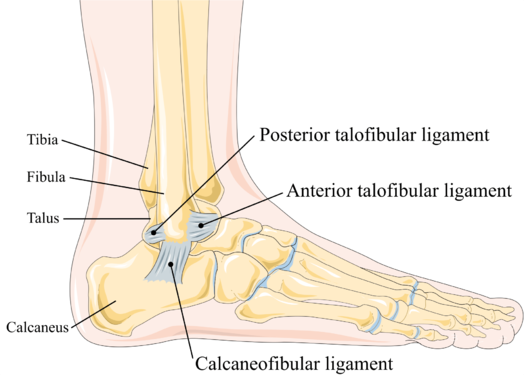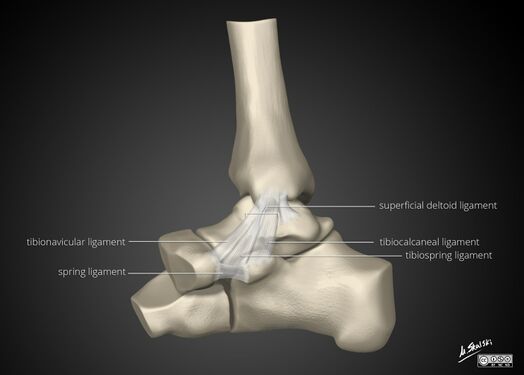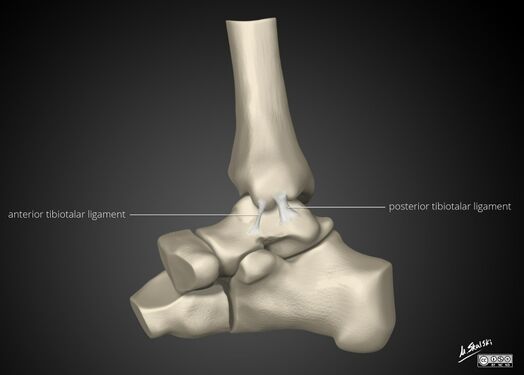Tibiotalar Joint (Talocrural Joint): Difference between revisions
No edit summary |
mNo edit summary |
||
| Line 31: | Line 31: | ||
* Medial collateral ligaments (deltoid ligaments). These resist eversion and valgus stresses. It is fan shaped and has anterior and posterior tibiotalar ligaments, the tibionavicular ligament, and the tibiocalcaneal ligament | * Medial collateral ligaments (deltoid ligaments). These resist eversion and valgus stresses. It is fan shaped and has anterior and posterior tibiotalar ligaments, the tibionavicular ligament, and the tibiocalcaneal ligament | ||
* Lateral collateral ligaments. These protect against inversion of the joint limiting varus stresses and reduce rotation. They are the anterior and posterior talofibular ligaments and the calcaneofibular ligament. The lateral ligaments are frequently injured during inversion injuries. The calcaneofibular ligament is the only direct soft tissue connection between the tibiotalar and [[Talocalcaneal Joint (Subtalar Joint)|subtalar joint]]. | * Lateral collateral ligaments. These protect against inversion of the joint limiting varus stresses and reduce rotation. They are the anterior and posterior talofibular ligaments and the calcaneofibular ligament. The lateral ligaments are frequently injured during inversion injuries. The calcaneofibular ligament is the only direct soft tissue connection between the tibiotalar and [[Talocalcaneal Joint (Subtalar Joint)|subtalar joint]]. | ||
<gallery mode="packed" heights="250"> | |||
File:Lateral collateral ligament of ankle.png|Lateral collateral ligament | |||
File:Deltoid ligament superficial layer.jpg|Deltoid ligament superficial layer | |||
File:Deltoid ligament deep layer.jpg|Deltoid ligament deep layer | |||
</gallery> | |||
[[Category:Foot and Ankle Anatomy]] | [[Category:Foot and Ankle Anatomy]] | ||
Revision as of 09:50, 18 July 2021
{{{{{quality}}}}}
| Tibiotalar Joint (Talocrural Joint) | |
|---|---|
| Synonym | Ankle joint, talocrural joint, tibiotalar joint |
| Primary Type | Diarthrodial hinge joint"Diarthrodial hinge joint" is not in the list (Synovial Joint, Cartilaginous Joint, Fibrous Joint, Compound Joint) of allowed values for the "Has joint type" property. |
| Secondary Type | |
| Bones | |
| Ligaments | Syndesmosis, medial collateral ligaments, lateral collateral ligaments |
| Muscles | |
| Innervation | tibial nerve, deep peroneal nerve |
| Vasculature | anterior and posterior tibial arteries, peroneal artery |
| ROM | Plantarflexion and dorsiflexion |
| Volume | |
| Conditions | |
The tibiotalar joint, also known as the ankle joint or talocrural joint, is formed by the junction between the distal tibia and fibula and the talus.
Bony Anatomy
The tibial-talar aspect bears the load. A mortise is formed by the distal aspects of the tibia and fibula, and the trochlea of the talus fits into this. The malleoli of the tibia and fibula constrain the talus forming a hinge joint providing plantarflexion and dorsiflexion of the foot.
The hinge terminology is somewhat of a simplification. The trochlea surface is cone-shaped and it has an oblique rotation axis. The talus is widest anteriorly, leading to the joint being most stable in a position of dorsiflexion.
Stability is provided by the joint geometry (especially in the stance phase of the gait) and the soft tissue structures.
The joint has a thin capsule that attaches to the tibia, malleoli, and talus.
Ligaments
There are three groups of ligaments that provide stability
- Tibiofibular syndemosis. This limits motion between the tibia and fibula. There are three parts - the anterior tibiofibular ligament, the posterior tibiofibular ligament, and the interosseous tibiofibular ligament
- Medial collateral ligaments (deltoid ligaments). These resist eversion and valgus stresses. It is fan shaped and has anterior and posterior tibiotalar ligaments, the tibionavicular ligament, and the tibiocalcaneal ligament
- Lateral collateral ligaments. These protect against inversion of the joint limiting varus stresses and reduce rotation. They are the anterior and posterior talofibular ligaments and the calcaneofibular ligament. The lateral ligaments are frequently injured during inversion injuries. The calcaneofibular ligament is the only direct soft tissue connection between the tibiotalar and subtalar joint.




